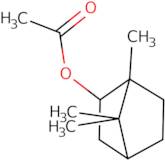Isobornyl Acetate
CAS: 125-12-2
Rif. 3D-FI45933
| 1kg | Fuori produzione | ||
| 2kg | Fuori produzione | ||
| 100g | Fuori produzione | ||
| 250g | Fuori produzione | ||
| 500g | Fuori produzione |
Informazioni sul prodotto
- (.+-.)-Isobornyl acetate
- Acetate de exo-1,7,7-trimethylbicyclo[2.2.1]hept-2-yle
- Acetate, 1,7,7-Trimethyl-Bicyclo[2.2.1]Hept-2-Yl, Exo-
- Acetato De Exo-1,7,7-Trimetilbiciclo[2.2.1]Hept-2-Ilo
- Acetic acid, isobornyl ester
- Bicyclo[2.2.1]heptan-2-ol, 1,7,7-trimethyl-, 2-acetate, (1R,2R,4R)-rel-
- Bicyclo[2.2.1]heptan-2-ol, 1,7,7-trimethyl-, acetate, exo-
- Essigsaeure-Isobornylester
- Exo-1,7,7-Trimethylbicyclo[2.2.1]Hept-2-Yl Acetate
- Isoborneol, acetate
- Vedi altri sinonimi
- Nsc 62486
- Pichtosin
- Pichtosine
- exo-1,7,7-Trimethylbicyclo[2.2.1]hept-2-ylacetat
- exo-1,7,7-Trimethylbicyclo[2.2.1]heptan-2-ol acetate
- exo-Bornyl acetate
- Isomethyl lonone
- (1R,2R,4S)-1,7,7-trimethylbicyclo[2.2.1]hept-2-yl acetate
- (1S,2S,4R)-1,7,7-trimethylbicyclo[2.2.1]hept-2-yl acetate
- (1S,2S,4S)-1,7,7-trimethylbicyclo[2.2.1]hept-2-yl acetate
- Isobornylacetate,90%
- Bicyclo[2.2.1]heptan-2-ol, 1,7,7-trimethyl-, acetate, (1R,2R,4R)-rel-
- (2R)-1,7,7-trimethylbicyclo[2.2.1]hept-2-yl acetate
Isobornyl Acetate is a terpene that is found in many plants, such as Triticum aestivum. It has been used as a cross-linking agent for the production of polyurethane foams and as a solid catalyst for reactions involving glycol ethers. Its elimination rate is low and it reacts with phosphotungstic acid to form an ester. The reaction mechanism starts with the addition of water to an α-pinene molecule followed by elimination of methanol. This process produces an acetate group. Isobornyl Acetate has been shown to react with glycol ethers in the presence of sodium citrate to produce polyester foam.





